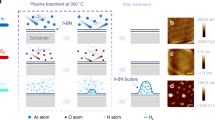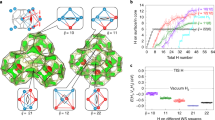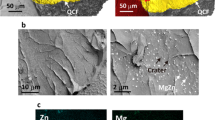Abstract
The presence of excess hydrogen at the interface between a metal substrate and a protective oxide can cause blistering1,2,3 and spallation of the scale4,5,6,7,8. However, it remains unclear how nanoscale bubbles manage to reach the critical size in the first place. Here, we perform in situ environmental transmission electron microscopy experiments of the aluminium metal/oxide interface under hydrogen exposure. It is found that once the interface is weakened by hydrogen segregation, surface diffusion of Al atoms initiates the formation of faceted cavities on the metal side, driven by Wulff reconstruction. The morphology and growth rate of these cavities are highly sensitive to the crystallographic orientation of the aluminium substrate. Once the cavities grow to a critical size, the internal gas pressure can become great enough to blister the oxide layer. Our findings have implications for understanding hydrogen damage of interfaces.
This is a preview of subscription content, access via your institution
Access options
Subscribe to this journal
Receive 12 print issues and online access
$259.00 per year
only $21.58 per issue
Buy this article
- Purchase on Springer Link
- Instant access to full article PDF
Prices may be subject to local taxes which are calculated during checkout





Similar content being viewed by others
References
Rozenak, P. Hemispherical bubbles growth on electrochemically charged aluminum with hydrogen. Int. J. Hydrog. Energy 32, 2816–2823 (2007).
Liu, Y. et al. Detachment of alumina films from aluminium by 100 keV H+ ions. Surf. Interface Anal. 33, 318–321 (2002).
Subanovic, M. et al. Blistering of MCrAlY-coatings in H2/H2O-atmospheres. Corros. Sci. 51, 446–450 (2009).
Sergo, V. & Clarke, D. R. Observation of subcritical spall propagation of a thermal barrier coating. J. Am. Ceram. Soc. 81, 3237–3242 (1998).
Saunders, S. R. J., Monteiro, M. & Rizzo, F. The oxidation behaviour of metals and alloys at high temperatures in atmospheres containing water vapour: A review. Prog. Mater. Sci. 53, 775–837 (2008).
Smialek, J. L. Moisture-induced TBC spallation on turbine blade samples. Surf. Coat. Technol. 206, 1577–1585 (2011).
Haynes, J. A., Unocic, K. A. & Pint, B. A. Effect of water vapor on the 1100 °C oxidation behavior of plasma-sprayed TBCs with HVOF NiCoCrAlX bond coatings. Surf. Coat. Technol. 215, 39–45 (2013).
Hultquist, G., Tveten, B. & Hornlund, E. Hydrogen in chromium: Influence on the high-temperature oxidation kinetics in H2O, oxide-growth mechanisms, and scale adherence. Oxid. Met. 54, 1–10 (2000).
Bailey, P. et al. Damage of alumina films by medium energy hydrogen and helium ions. Nucl. Instrum. Methods Phys. Res. B 197, 265–270 (2002).
Tokunaga, K. et al. Blister formation and deuterium retention on tungsten exposed to low energy and high flux deuterium plasma. J. Nucl. Mater. 337, 887–891 (2005).
Lu, G. H., Zhou, H. B. & Becquart, C. S. A review of modelling and simulation of hydrogen behaviour in tungsten at different scales. Nucl. Fusion 54, 086001 (2014).
Scamans, G. M. & Rehal, A. S. Electron metallography of the aluminium-water vapour reaction and its relevance to stress-corrosion susceptibility. J. Mater. Sci. 14, 2459–2470 (1979).
Sznajder, M. & Geppert, U. in Advances in Solar Sailing (ed. Macdonald, M.) 559–571 Ch. 35, (Springer, 2014).
Condon, J. B. & Schober, T. Hydrogen bubbles in metals. J. Nucl. Mater. 207, 1–24 (1993).
Liu, Y. L. et al. Vacancy trapping mechanism for hydrogen bubble formation in metal. Phys. Rev. B 79, 172103 (2009).
Flower, H. M. Electron-irradiation induced aqueous corrosion of aluminum and magnesium. Radiat. Eff. Defects Solids 33, 173–179 (1977).
Bond, G. M., Robertson, I. M. & Birnbaum, H. K. On the determination of the hydrogen fugacity in an environmental cell TEM facility. Scr. Metall. 20, 653–658 (1986).
Das, S. K. & Kaminsky, M. Radiation Effects on Solid Surfaces Vol. 158, Ch. 5, 112–170 (Advances in Chemistry, American Chemical Society, 1976).
Tian, L., Li, J., Sun, J., Ma, E. & Shan, Z. W. Visualizing size-dependent deformation mechanism transition in Sn. Sci. Rep. 3, 2113 (2013).
Sun, J. et al. Liquid-like pseudoelasticity of sub-10-nm crystalline silver particles. Nature Mater. 13, 1007–1012 (2014).
Oriani, R. A. & Josephic, P. H. Equilibrium aspects of hydrogen-induced cracking of steels. Acta Metall. 22, 1065–1074 (1974).
Oriani, R. A. Hydrogen embrittlement of steels. Annu. Rev. Mater. Sci. 8, 327–357 (1978).
Daw, M. S. & Baskes, M. I. Semiempirical, quantum mechanical calculation of hydrogen embrittlement in metals. Phys. Rev. Lett. 50, 1285–1288 (1983).
Mullins, W. W. Flattening of a nearly plane solid surface due to capillarity. J. Appl. Phys. 30, 77–83 (1959).
Keeffe, M. E., Umbach, C. C. & Blakely, J. M. Surface self-diffusion on Si from the evolution of periodic atomic step arrays. J. Phys. Chem. Solids 55, 965–973 (1994).
Tu, K. N. Solder Joint Technology Vol. 117, Ch. 8, 211–243 (Springer Series in Materials Science, Springer, 2007).
Shewmon, P. Diffusion in Solids Ch. 6, 189–222 (Minerals, Metals & Materials Society, 1989).
Vitos, L., Ruban, A., Skriver, H. L. & Kollar, J. The surface energy of metals. Surf. Sci. 411, 186–202 (1998).
Leyens, C., Fritscher, K., Gehrling, R., Peters, M. & Kaysser, W. A. Oxide scale formation on an MCrAlY coating in various H2–H2O atmospheres. Surf. Coat. Technol. 82, 133–144 (1996).
Acknowledgements
The authors acknowledge support from the Natural Science Foundation of China (51231005, 11132006, 51401159 and 51321003), and 973 Programs of China (2012CB619402). We also appreciate the support from the 111 project (B06025). J.L. acknowledges support by NSF DMR-1120901 and DMR-1410636. E.M. acknowledges support from US DoE-BES-DMSE, under Contract No. DE-FG02-09ER46056. We also thank P. H. Lu and M. Li for assistance in EELS characterization and data processing.
Author information
Authors and Affiliations
Contributions
Z.-W.S., J.L. and E.M. conceived and designed the project. D.-G.X. conducted the experimental work. D.-G.X., Z.-W.S., J.L. and E.M. wrote the paper. All authors contributed to discussions of the results.
Corresponding authors
Ethics declarations
Competing interests
The authors declare no competing financial interests.
Supplementary information
Supplementary Information
Supplementary Information (PDF 2023 kb)
Supplementary Information
Supplementary Movie 1 (MP4 27993 kb)
Supplementary Information
Supplementary Movie 2 (MP4 10575 kb)
Rights and permissions
About this article
Cite this article
Xie, DG., Wang, ZJ., Sun, J. et al. In situ study of the initiation of hydrogen bubbles at the aluminium metal/oxide interface. Nature Mater 14, 899–903 (2015). https://doi.org/10.1038/nmat4336
Received:
Accepted:
Published:
Issue Date:
DOI: https://doi.org/10.1038/nmat4336
This article is cited by
-
Spectroscopic visualization of reversible hydrogen spillover between palladium and metal–organic frameworks toward catalytic semihydrogenation
Nature Communications (2024)
-
How solute atoms control aqueous corrosion of Al-alloys
Nature Communications (2024)
-
Quantitative tests revealing hydrogen-enhanced dislocation motion in α-iron
Nature Materials (2023)
-
Boosting photocatalytic hydrogen production from water by photothermally induced biphase systems
Nature Communications (2021)
-
Formation and elimination mechanism of thermal blistering in Al2O3/Si system
Journal of Materials Science (2021)



